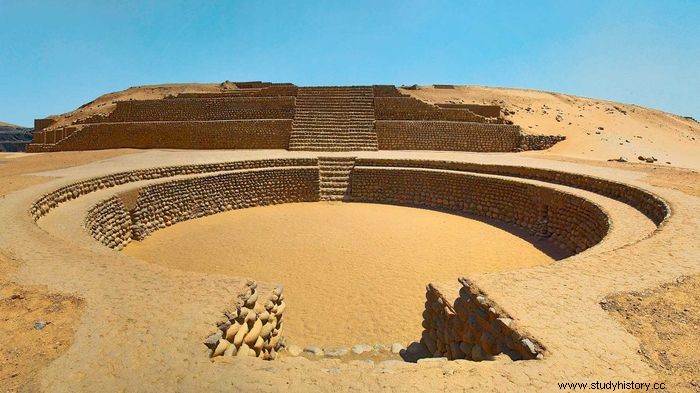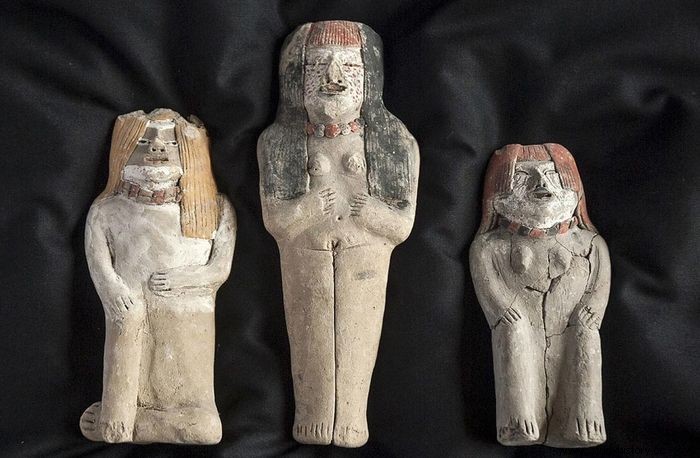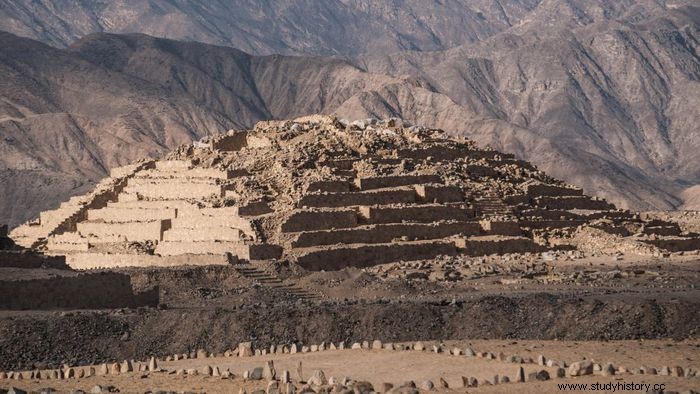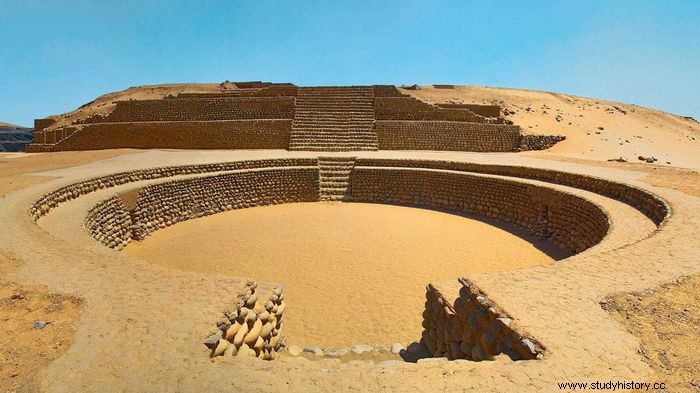Six mounds of earth and rock emerge from the dry desert of SupeValley near the coast of Peru. They appear to be nature's handicrafts, desolate outposts in a dry area trapped between the Pacific and Andean Cordillera folds, dunes and vast expanses. Appearance can be tricky, however. These are man-made pyramids, and compelling new evidence suggests that they represent the remains of a nearly 5,000-year-old metropolis. If this is true, it will be the oldest city in America and one of the oldest. It's Caral Civilization!
Like the 150-acre complex of huge pyramids, squares and residential buildings, Caral was a lively metropolis similar to Egypt's great pyramids. According to a comprehensive study conducted by Peruvian archaeologist Ruth Shady Sols of San Marcos University. Caral is believed to answer questions about the long mysterious origins of Inca civilization, which originally stretched from present-day Ecuador to central Chile and gave home to cities such as Cuzco and Machu Picchu. It may contain the key to the origins of all civilizations.
Caral was discovered in 1905, but received little attention, due to archaeologists' belief that the intricate structures were relatively new. As a result, Caral's excavations have only recently begun.
Where's Caral?
Caral is located 14 miles from the sea and 120 miles north of Lima, the capital of Peru. It is in a desert region without paved roads, electricity or public water. Caral is where the Andean culture began. Then, around 5,000 years old, Caral emerged along with other major cultures in Mesopotamia, Egypt, and China.
This holy city was populated by talented fishermen, farmers and professional sailors and was located in the center of the Supe Valley, in the middle of fertile grounds near the sea. Six large pyramids previously existed among the city's many brick structures and circular squares.
Caral, now a UNESCO World Heritage Site, was once an impressive metropolitan center, and its agricultural skills and environmental practices are still used as a model today.
America's oldest civilization
According to archaeologists, Caral is pre-ceramic, which means that it existed before it developed pot-burning technology in the area. It was 1,000 years before the Olmec settlements in the north.
After thorough excavations, Caral discovered stairwells, circular walls with traces of colorful plaster and square masonry. In addition, remnants of reeds woven into bags, known as shicras, were discovered in the foundation. Excavators believe that the first workers filled these sacks with stones from a quarry on a slope one kilometer away, stacking them within retaining walls, and gradually forming the massive structures of the city of Caral.
A summary of Caral's findings

Archaeologists were amazed not only by Caral's age but also by its complexity and scale. It was a 60 foot high area about the size of four football fields. A 30-foot-wide exciting staircase rises from a deep, circular space at the base of the pyramid, and passes through three terraced levels before reaching the top of the platform, which has the ruins of an atrium and a massive fireplace. Thousands of manual workers, not to mention architects, craftsmen, supervisors and other management, would have been required to complete such a massive mission.
In addition, a large underground amphitheater exists within a ring of platform pyramids, which may have held hundreds of people during civil or religious ceremonies. Excavators discovered 32 whistles made of pelican and condor bones inside the theater. In addition, they discovered 37 deer cornetets and llama bones later in April 2002. It declared that music was important in the Caral community.
Several smaller mounds, buildings and residential complexes are located on the outskirts of Caral. A hierarchy of settlements was discovered, with huge, well-kept apartments at the top of the pyramids for the elite, ground-level complexes for artisans, and more shabby peripheral slums for workers.
The public and domestic structures did not serve a single exclusively religious, political or residential purpose, but served many roles and included workspaces. The elite's homes reflected some of the dimensions of the public buildings to which they were attached on a smaller scale.
Caral's in-depth discovery

According to the findings, Caral operated as a major commercial center for the region, including everything from the Amazon rainforests to the Andes. As a result, remnants of achiote fruit were discovered, a plant still used as an aphrodisiac in today's rainforest.
In addition, there were snail chains and coca plant seeds, none of which were endemic to Caral. This prosperous trading environment gave rise to an elite group of people who did not participate in the food production process, so that they could become priests, planners, builders and designers. As a result, the essential class divisions in an urban society developed.
Remains of sardines and anchovies, which are said to have come from the coast 14 kilometers to the west, were discovered in the excavations. The Caral people also ate squash, sweet potatoes and beans, according to the findings. Caral's early farmers led to nearby rivers in trenches and canals to irrigate their farms, which still cross the SupeValley today.
However, archaeologists determined that Caral's trade influence was not based on the storage of food supplies because there was no evidence of corn (corn) or other grains, which could be traded or stored and used to get a population over in bad times.
Remarkable findings
Archaeologists discovered another crop in the excavations that provided the key to Caral's success. There were finds of cotton seeds, fibers and textiles in large quantities in practically all excavated buildings. In addition, a massive fishing net that was discovered in an incoherent place off the coast of Peru was as old as Caral.
Essentially, the people of Caral enabled fishermen to use larger and more efficient nets, giving them access to more marine resources. Dried squash rose as a floating device for nets and as a container of the Caral people, eliminating the need for ceramics.
Archaeologists have unearthed 17 more pyramid complexes spread over SupeValley's 35 square kilometers. Then, around 1600 BC, the Caral civilization fell apart for unknown reasons, although it did not disappear suddenly. Archaeologists believe Caral was the mother city of the Inca civilization because of its size and scope.
Highlights from Caral Civilization
- The Caral civilization was a significant part of the Norte Chico cultural complex. The Norte Chico region is located on the northern coast of Peru.
- Caral's urban complex covers more than 150 acres and includes squares, homes and a 28 meter high temple.
- Some historians believe Norte Chico appeared to be developing seafood and marine resources instead of agricultural grains and crop surpluses.
- One of the artifacts found at Caral is a quipu, a knot of cloth that archaeologists believe was used to keep records.
- There has been no evidence of warfare in Caral.
- Marco Machacuay and Rocio Aramburu uncovered a geoglyph of a figure with long hair and an open mouth just west of Caral in 2000.
- Caral is believed to have had around 3,000 people in his heyday.
- The Norte Chico civilizations are pre-Columbian Central Archaic pre-ceramic cultures that lacked pottery and appeared to have little art. However, the monumental architecture of ancient civilizations was their most astonishing feat.
The Caral civilization was a complex pre-Columbian society. It had centers in Supe, Barranca province, Peru. Due to its location, it served on three rivers:Fortaleza, Pativilca and Supe. As a result, it emerged as the oldest civilization in America and one of the six sites in the ancient globe where civilizations independently arose.
Between the 30s and 18s BC, Caral flourished. This complex culture originated in Mesopotamia a millennium after Sumer, was at the same time as the Egyptian pyramids, and about two millennia before the Mesoamerican Olmec.
Archaeological interest in Caral

Paul Kosok discovered Caral in 1948, and archaeologist Ruth Shady further investigated it. Caral's urban complex covers more than 150 acres and includes squares, homes and a 28 meter high temple. Andean cultures used this city plan for the next four thousand years. An intertwined piece of textile known as a quipu appeared at Caral, and archaeologists believe it stored records.
There were finds of flutes of condor and pelican bones and cornets of deer and llama bones. There has been no evidence of warfare. Marco Machacuay and Rocio Aramburu discovered a geoglyph west of Caral in 2000. The etching lines resemble a human face with long hair and an open mouth. Caral had a population of around 3,000 people in his heyday.
Norte-Chico
According to archeological nomenclature, Norte Chico civilizations are pre-Columbian Central Archaic pre-ceramic societies that lacked pottery and had no art. The colossal architecture of these civilizations, which included massive earthworks platform mounds and underground circular squares, was their most impressive achievement. Archaeological evidence suggests textile engineering and the potential worship of common deities, which exist in pre-Columbian Andean tribes.
To manage the old Norte Chico, a sophisticated government was essential. However, there are still concerns about the structure, especially the political impact of food resources. According to some researchers, Norte Chico was dependent on seafood and marine resources rather than on agricultural grains and crop surpluses. These were necessary for the emergence of other ancient civilizations.
Aspero
Another important site is Aspero, an area of 15 hectares (37 acres) at the mouth of the Supe River that has at least six platform mounds, the largest of which has a capacity of 3,200 cubic meters (4200 cubic meters), stands at 4 meters (13 feet) high , covering an area of 40 × 40 meters (130 × 130 feet).
The mounds contain U-shaped atria and several clusters of painted rooms with increasingly limited access, built of cobblestone and basalt block walls plastered with clay and shicra fill. Huaca de los Sacrificios and Huaca de los Idolos are two large platform mounds on the site, with another 15 smaller mounds. Squares, terraces and large rubbish dumps are among the other structures.
Huaca de los Sacrificios and Huaca de los Idolos, two ceremonial buildings in Aspero, are among the earliest instances of public architecture in America. Huaca de los Idolos got its name from an offering of many human figures (interpreted as idols) found at the platform's summit. Aspero's radiocarbon dates range from 3650 to 2420 BCE
The holy city of Caral Supe

The rise of civilization in America is the holy city of Caral-Supe. It is unique for its intricacies and impact on growing communities throughout the Supe Valley. It is beyond as a full-fledged socio-political entity. Quipus' early use as a recording device is significant. The huge platform mounds and the open circular paths are powerful and influential emblems of a consolidated state. It is also the delicate and masterful design of the city's architectural and spatial components.
Caral is a unique example of the late Archaic architecture and urban design of ancient Peruvian civilization. Over generations, the mounds of platforms, sunken circular courts and urban design influenced adjacent communities. As a result, there were effects on much of the Peruvian coast.
Caral is the most sophisticated and intricate example of settlement in the Supe Valley, the earliest known manifestation of civilization in America (the late Archaic period). It's spectacular in terms of its architectural and spatial design and complexity, especially its giant earth mounds and sunken circular courts, which dominated much of the Peruvian coast for eternity.
Ethnicity for Caral
Caral is unusually well preserved due to his early abandonment and late discovery. It appears to have undergone excavations only twice, and not systematically, after it was abandoned.
- One in the so-called Middle Formative or Early Horizon, around 1000 BC
- Another between 900 and 1440 AD, during the State and Lordships period.
The historic architectural structures were not distributed because these communities were on the outskirts of the city. Furthermore, there were restrictions on looting because the place had no gold and silver finds. Near the site there are no modern permanent structures (apart from tourism facilities of local materials). It is part of a wonderful cultural and natural setting that has remained relatively undeveloped.
Most development has taken place in low valley areas near Lima (south of the site). The area is located in the center of the Supe Valley, which is about non-industrialized agriculture. There is little doubt about the validity of the site. The Caral-Supe Special Archaeological Project (PEACS) conducted a radiocarbon study at the Caral site. It confirmed that the construction of the site took place between 3000 and 1800 BC. More precisely, it was during the late Archaic period.
the conclusion
The Caral civilization laid the foundations for a social, political and religious organization, cross-management of territories and resources, knowledge production and technological application, and other cultural expressions endured throughout the Andean cultural process.
Caral Civilization, one of the oldest and most widespread civilizations in America, holds the key to the West as the mother of Civilization. The current management system is sufficient, and a new management plan (from the end of 2008) is underway. The new design includes measures to ensure the property's preservation and preservation. It is a well-known tourist destination, with several visitors flocking to observe the excavations in recent years.
